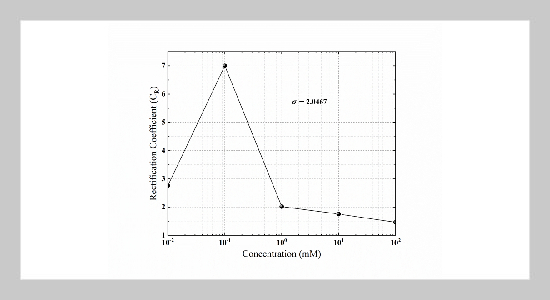- [1] S. J. Davis, M. Macha, A. Chernev, D. M. Huang, A. Radenovic, and S. Marion, (2020) “Pressure-induced enlargement and ionic current rectification in symmetric nanopores" Nano letters 20(11): 8089–8095. DOI: 10.1021/acs.nanolett.0c03083.
- [2] J.-P. Hsu, S.-T. Yang, C.-Y. Lin, and S. Tseng, (2017) “Ionic current rectification in a conical nanopore: Influences of electroosmotic flow and type of salt" The Journal of Physical Chemistry C 121(8): 4576–4582. DOI: 10 .1021/acs.jpcc.6b09907.
- [3] C. Wen, S. Zeng, S. Li, Z. Zhang, and S.-L. Zhang, (2019) “On rectification of ionic current in nanopores" Analytical chemistry 91(22): 14597–14604. DOI: 10.1021/acs.analchem.9b03685.
- [4] L. Ma, Z. Li, Z. Yuan, C. Huang, Z. S. Siwy, and Y. Qiu, (2020) “Modulation of ionic current rectification in ultrashort conical nanopores" Analytical Chemistry 92(24): 16188–16196. DOI: 10.1021/acs.analchem.0c03989.
- [5] J.-Y. Lin, C.-Y. Lin, J.-P. Hsu, and S. Tseng, (2016) “Ionic current rectification in a pH-tunable polyelectrolyte brushes functionalized conical nanopore: effect of salt gradient" Analytical chemistry 88(2): 1176–1187. DOI: 10.1021/acs.analchem.5b03074.
- [6] Z. Siwy, P. Apel, D. Dobrev, R. Neumann, R. Spohr, C. Trautmann, and K. Voss, (2003) “Ion transport through asymmetric nanopores prepared by ion track etching" Nuclear Instruments and Methods in Physics Research Section B: Beam Interactions with Materials and Atoms 208: 143–148. DOI: 10.1016/S0168-583X(03)00884-X.
- [7] T. Ma, P. Gaigalas, M. Lepoitevin, I. Plikusiene, M. Bechelany, J.-M. Janot, E. Balanzat, and S. Balme, (2018) “Impact of polyelectrolyte multilayers on the ionic current rectification of conical nanopores" Langmuir 34(11): 3405-3412. DOI: 10.1021/acs.langmuir.8b00222.
- [8] Y. Qiu, Z. S. Siwy, and M. Wanunu, (2018) “Abnormal ionic-current rectification caused by reversed electroosmotic flow under viscosity gradients across thin nanopores" Analytical chemistry 91(1): 996–1004. DOI: 10.1021/acs.analchem.8b04225.
- [9] C. Fang, P. Zhao, B. Cui, L. Wang, D. Liu, and S. Xie, (2010) “Current rectification in single molecule C59N: Effect of molecular polarity induced dipole moment" Physics Letters A 374(43): 4465–4470. DOI: 10.1016/j.physleta.2010.09.004.
- [10] A. Sadeghi, M. Azari, and S. Hardt, (2019) “Electroosmotic flow in soft microchannels at high grafting densities" Physical Review Fluids 4(6): 063701. DOI: 10.1103/PhysRevFluids.4.063701.
- [11] M. Khatibi, S. N. Ashrafizadeh, and A. Sadeghi, (2020) “Covering the conical nanochannels with dense polyelectrolyte layers significantly improves the ionic current rectification" Analytica Chimica Acta 1122: 48–60. DOI: 10.1016/j.aca.2020.05.011.
- [12] C. Kubeil and A. Bund, (2011) “The role of nanopore geometry for the rectification of ionic currents" The Journal of Physical Chemistry C 115(16): 7866–7873. DOI: 10.1021/jp111377h.
- [13] R. B. Schoch, H. Van Lintel, and P. Renaud, (2005) “Effect of the surface charge on ion transport through nanoslits" Physics of Fluids 17(10): 100604. DOI: 10.1063/1.1896936.
- [14] S. Pennathur and J. G. Santiago, (2005) “Electrokinetic transport in nanochannels. 2. Experiments" Analytical chemistry 77(21): 6782–6789. DOI: 10.1021/ac0508346.
- [15] J. Zhao, G. He, S. Huang, L. Villalobos, M. Dakhchoune, H. Bassas, and K. Agrawal, (2019) “Etching gas-sieving nanopores in single-layer graphene with an angstrom precision for high-performance gas mixture separation" Science advances 5(1): eaav1851. DOI: 10.1126/sciadv.aav1851.
- [16] O. N. Assad, T. Gilboa, J. Spitzberg, M. Juhasz, E.Weinhold, and A. Meller, (2017) “Light-enhancing plasmonic-nanopore biosensor for superior singlemolecule detection" Advanced Materials 29(9): 1–9. DOI: 10.1002/adma.201605442.
- [17] J. D. Spitzberg, A. Zrehen, X. F. van Kooten, and A. Meller, (2019) “Plasmonic-nanopore biosensors for superior single-molecule detection" Advanced Materials 31(23): 1900422. DOI: 10.1002/adma.201900422.
- [18] L. Liu and K. Zhang, (2018) “Nanopore-based strategy for sequential separation of heavy-metal ions in water" Environmental science & technology 52(10): 5884–5891. DOI: 10.1021/acs.est.7b06706.
- [19] M. Shankla and A. Aksimentiev, (2019) “Step-defect guided delivery of DNA to a graphene nanopore" Nature nanotechnology 14(9): 858–865. DOI: 10.1038/s41565-019-0514-y.
- [20] C. A. Morris, A. K. Friedman, and L. A. Baker, (2010) “Applications of nanopipettes in the analytical sciences" Analyst 135(9): 2190–2202. DOI: 10.1039/C0AN00156B.
- [21] X. Shi, D. V. Verschueren, and C. Dekker, (2018) “Active delivery of single DNA molecules into a plasmonic nanopore for label-free optical sensing" Nano letters 18(12): 8003–8010. DOI: 10.1021/acs.nanolett.8b04146.
- [22] Y. Feng, Y. Zhang, C. Ying, D. Wang, and C. Du, (2015) “Nanopore-based fourth-generation DNA sequencing technology" Genomics, proteomics & bioinformatics 13(1): 4–16. DOI: 10.1016/j.gpb.2015.01.009.
- [23] J. Sengenès, A. Daunay, M.-A. Charles, and J. Tost, (2010) “Quality control and single nucleotide resolution analysis of methylated DNA immunoprecipitation products" Analytical biochemistry 407(1): 141–143. DOI: 10.1016/j.ab.2010.07.013.
- [24] C. A. Merchant, K. Healy, M. Wanunu, V. Ray, N. Peterman, J. Bartel, M. D. Fischbein, K. Venta, Z. Luo, A. C. Johnson, et al., (2010) “DNA translocation through graphene nanopores" Nano letters 10(8): 2915–2921. DOI: 10.1021/nl102069z.
- [25] D. M. Vlassarev and J. A. Golovchenko, (2012) “Trapping DNA near a solid-state nanopore" Biophysical Journal 103(2): 352–356. DOI: 10.1016/j .bpj.2012.06.008.
- [26] R. Chen, R. J. Balla, A. Lima, and S. Amemiya, (2017) “Characterization of nanopipet-supported ITIES tips for scanning electrochemical microscopy of single solid-state nanopores" Analytical chemistry 89(18): 9946–9952. DOI: 10.1021/acs.analchem.7b02269.
- [27] M. Nazari, A. Davoodabadi, D. Huang, T. Luo, and H. Ghasemi, (2020) “On interfacial viscosity in nanochannels" Nanoscale 12(27): 14626–14635. DOI: 10.1039/D0NR02294B.
- [28] S. Fujiwara, K. Morikawa, T. Endo, H. Hisamoto, and K. Sueyoshi, (2020) “Size sorting of exosomes by tuning the thicknesses of the electric double layers on a micronanofluidic device" Micromachines 11(5): 458. DOI:
10.3390/mi11050458.
- [29] A. Alizadeh, W.-L. Hsu, M. Wang, and H. Daiguji, (2021) “Electroosmotic flow: From microfluidics to nanofluidics" Electrophoresis 42(7-8): 834–868. DOI: 10.1002/elps.202000313.
- [30] A. Gupta, P. J. Zuk, and H. A. Stone, (2020) “Charging dynamics of overlapping double layers in a cylindrical nanopore" Physical review letters 125(7): 076001. DOI: 10.1103/PhysRevLett.125.076001.
- [31] F. Baldessari, (2008) “Electrokinetics in nanochannels: Part I. Electric double layer overlap and channel-to-well equilibrium" Journal of colloid and interface science 325(2): 526–538. DOI: 10.1016/j.jcis.2008.06.007.
















